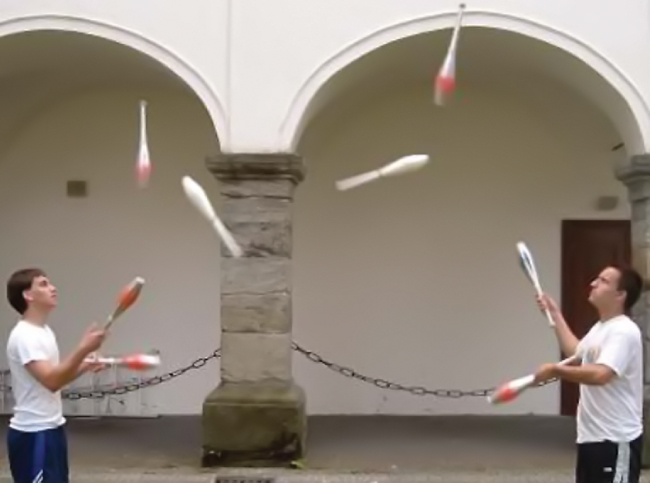| << Chapter < Page | Chapter >> Page > |
A chemical reaction is usually written in a way that suggests it proceeds in one direction, the direction in which we read, but all chemical reactions are reversible, and both the forward and reverse reaction occur to one degree or another depending on conditions. In a chemical equilibrium , the forward and reverse reactions occur at equal rates, and the concentrations of products and reactants remain constant. If we run a reaction in a closed system so that the products cannot escape, we often find the reaction does not give a 100% yield of products. Instead, some reactants remain after the concentrations stop changing. At this point, when there is no further change in concentrations of reactants and products, we say the reaction is at equilibrium. A mixture of reactants and products is found at equilibrium.
For example, when we place a sample of dinitrogen tetroxide (N 2 O 4 , a colorless gas) in a glass tube, it forms nitrogen dioxide (NO 2 , a brown gas) by the reaction
The color becomes darker as N 2 O 4 is converted to NO 2 . When the system reaches equilibrium, both N 2 O 4 and NO 2 are present ( [link] ).
![A three-part diagram is shown. At the top of the diagram, three beakers are shown, and each one contains a sealed tube. The tube in the left beaker is full of a colorless gas which is connected to a zoom-in view of the particles in the tube by a downward-facing arrow. This particle view shows seven particles, each composed of two connected blue spheres. Each blue sphere is connected to two red spheres. The tube in the middle beaker is full of a light brown gas which is connected to a zoom-in view of the particles in the tube by a downward-facing arrow. This particle view shows nine particles, five of which are composed of two connected blue spheres. Each blue sphere is connected to two red spheres. The remaining four are composed of two red spheres connected to a blue sphere. The tube in the right beaker is full of a brown gas which is connected to a zoom-in view of the particles in the tube by a downward-facing arrow. This particle view shows eleven particles, three of which are composed of two connected blue spheres. Each blue sphere is connected to two red spheres. The remaining eight are composed of two red spheres connected to a blue sphere. At the bottom of the image are two graphs. The left graph has a y-axis labeled, “Concentration,” and an x-axis labeled, “Time.” A red line labeled, “N O subscript 2,” begins in the bottom left corner of the graph at a point labeled, “0,” and rises near the highest point on the y-axis before it levels off and becomes horizontal. A blue line labeled, “N subscript 2 O subscript 4,” begins near the highest point on the y-axis and drops below the midpoint of the y-axis before leveling off. The right graph has a y-axis labeled, “Rate,” and an x-axis labeled, “Time.” A red line labeled, “k subscript f, [ N subscript 2 O subscript 4 ],” begins in the bottom left corner of the graph at a point labeled, “0,” and rises near the middle of the y-axis before it levels off and becomes horizontal. A blue line labeled, “k subscript f, [ N O subscript 2 ] superscript 2,” begins near the highest point on the y-axis and drops to the same point on the y-axis as the red line before leveling off. The point where both lines become horizontal is labeled, “Equilibrium achieved.”](/ocw/mirror/col11760/m51108/CNX_Chem_13_01_equilibrium.jpg)
The formation of NO 2 from N 2 O 4 is a reversible reaction , which is identified by the equilibrium arrow . All reactions are reversible, but many reactions, for all practical purposes, proceed in one direction until the reactants are exhausted and will reverse only under certain conditions. Such reactions are often depicted with a one-way arrow from reactants to products. Many other reactions, such as the formation of NO 2 from N 2 O 4 , are reversible under more easily obtainable conditions and, therefore, are named as such. In a reversible reaction, the reactants can combine to form products and the products can react to form the reactants. Thus, not only can N 2 O 4 decompose to form NO 2 , but the NO 2 produced can react to form N 2 O 4 . As soon as the forward reaction produces any NO 2 , the reverse reaction begins and NO 2 starts to react to form N 2 O 4 . At equilibrium, the concentrations of N 2 O 4 and NO 2 no longer change because the rate of formation of NO 2 is exactly equal to the rate of consumption of NO 2 , and the rate of formation of N 2 O 4 is exactly equal to the rate of consumption of N 2 O 4 . Chemical equilibrium is a dynamic process : As with the swimmers and the sunbathers, the numbers of each remain constant, yet there is a flux back and forth between them ( [link] ).


Notification Switch
Would you like to follow the 'Chemistry' conversation and receive update notifications?